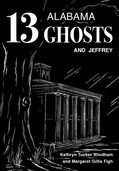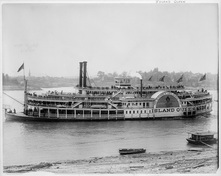
This we know: The Eliza Battle, the phantom vessel of legend, did exist. According to Rufus Ward, author of The Tombigbee River Steamboats: Rollodores, Dead Heads, and Side-wheelers, the Eliza Battle was a side-wheeler steamboat that weighed 315 tons. She had a reputation for great quality and great size among the steamboats of the Upper Tombigbee trade. The Eliza Battle left her history behind in several records, including the documentation of a lawsuit and the stories of a time the craft caught fire but survived.
This escape, however, was not a feat that could be repeated on March 1, 1858. The setting was what we would expect from a ghost story’s origin: a dark and stormy night on the stretch of the Tombigbee River by Kemp’s landing. Once again, the Eliza Battle caught fire. The cause is uncertain. There are rumors that a robber lit the blaze, but the most likely cause was sparks emitted by a passing steamboat that ignited the cotton the Battle was transporting.
The fire pumps that saved the ship previously were powerless on this tragic night. As the fire spread and destroyed the steering mechanisms, passengers abandoned ship, many freezing to death in the cold water or in trees as they waited for help.
Our knowledge of this tragedy comes mainly from the survivors’ stories and newspaper articles from around the world. The numerous accounts vary, but they make it clear that the Eliza Battle disaster captured the attention and imagination of people everywhere. It can be no surprise that a ghost story about the steamboat began to circulate.
As 13 Alabama Ghosts and Jeffrey relates, people close to the Tombigbee River sometimes hear music drifting toward them from the water, often accompanied by screams of people begging for rescue. Some people even see the ghost of the Eliza Battle floating down the river toward its never-reached destination of Mobile.
It’s certainly a chilling tale, perhaps even more so since all the events leading up to the phantom steamboat’s appearance were so horrific. Perhaps it’s the fact that the ghost story was born of a true story that makes it so frightening. Where does the line between fact and fantasy fall? That’s for you to decide.
 Rebecca Mast
Rebecca Mast(Madison, Alabama)
Rebecca Mast is a senior at the University of Alabama. She is an English major, minoring in creative writing and French. When she’s not searching through fascinating historical records, she enjoys reading, drawing, and playing clarinet with the Million Dollar Band.
References
Ward, Rufus. The Tombigbee River Steamboats: Rollodores, Dead Heads, and Side-wheelers. Charleston, SC: The History Press, 2010. Web.
Windham, Kathryn Windham and Margaret Gillis Figh. 13 Alabama Ghosts and Jeffrey: Commemorative Edition. Tuscaloosa, AL: The University of Alabama Press, 2014. Print.

 RSS Feed
RSS Feed